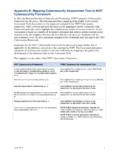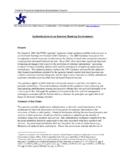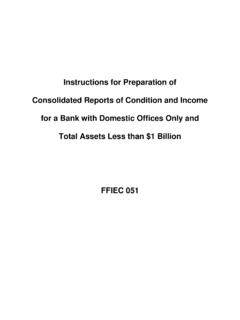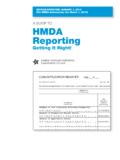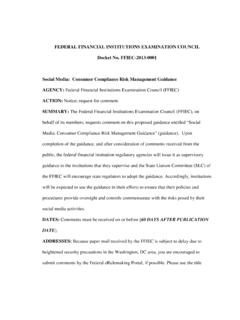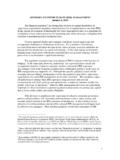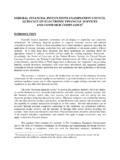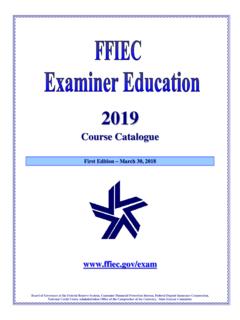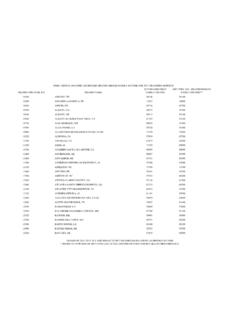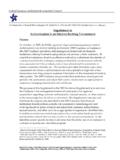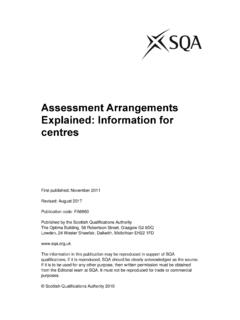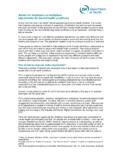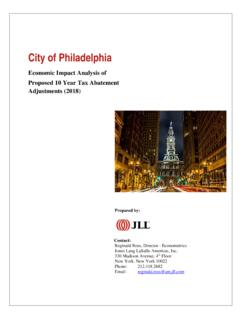Transcription of COMMUNITY REINVESTMENT ACT - FFIEC Home Page
1 Small Institution CRA Examination Procedures OCC, FRB, FDIC and OTS- July 2007 1 COMMUNITY REINVESTMENT ACT EXAMINATION PROCEDURES FOR SMALL INSTITUTIONS Examination Scope 1. For institutions with more than one assessment area, identify assessment areas for full scope review. In making those selections, review prior CRA performance evaluations, available COMMUNITY contact materials, and reported lending data and demographic data on each assessment area. Consider factors such as: a. The lending opportunities in the different assessment areas; b. The level of the institution s lending activity in the different assessment areas, including low- and moderate-income areas, designated disaster areas, or distressed or underserved nonmetropolitan middle-income geographies designated by the Agencies1 based on (a) rates of poverty, unemployment, and population loss or (b) population size, density, and dispersion;2 c.
2 The number of other institutions in the different assessment areas and the importance of the institution under examination in serving the different areas, particularly any areas with relatively few other providers of financial services; d. The existence of apparent anomalies in the reported HMDA data for any particular assessment area(s); e. The length of time since the assessment area(s) was last examined using a full scope review; f. The institution s prior CRA performance in different assessment areas; g. Examiners knowledge of the same or similar assessment areas; and h. Comments from the public regarding the institution s CRA performance. 2. For interstate institutions, a rating must be assigned for each state where the institution 1 The Board of Governors of the Federal Reserve System, the Federal Deposit Insurance Corporation, the Office of the Comptroller of the Currency, and the Office of Thrift Supervision.
3 2 A list of distressed or underserved nonmetropolitan middle-income geographies is available on the FFIEC web site at Small Institution CRA Examination Procedures OCC, FRB, FDIC and OTS- July 2007 2 has a branch and for each multi-state MSA or metropolitan division (MD) where the institution has branches in two or more states that comprise that multi-state MSA/MD. Select one or more assessment areas in each state for examination using these procedures. Performance Context 1. Review standardized worksheets and other agency information sources to obtain relevant demographic, economic and loan data, to the extent available, for each assessment area under review. 2. Obtain for review the Consolidated Reports of Condition (Call Reports) / Thrift Financial Reports (TFR), Uniform Bank Performance Reports (UBPR) / Uniform Thrift Performance Reports (UTPR), annual reports, supervisory reports, and prior CRA evaluations of the institution under examination.
4 Review financial information and the prior CRA evaluations of institutions of similar size that serve the same or similar assessment area(s). 3. Consider any information the institution may provide on its local COMMUNITY and economy, its business strategy, its lending capacity, or that otherwise assists in the evaluation of the institution. 4. Review COMMUNITY contact forms prepared by the regulatory agencies to obtain information that assists in the evaluation of the institution. Contact local COMMUNITY , governmental or economic development representatives to update or supplement this information. Refer to the COMMUNITY Contact Procedures for more detail.
5 5. Review the institution s public file for any comments received by the institution or the agency since the last CRA performance evaluation for information that assists in the evaluation of the institution. 6. Document the performance context information gathered for use in evaluating the institution s performance. assessment Area 1. Review the institution s stated assessment area(s) to ensure that it: a. Consists of one or more MSAs/MDs or contiguous political subdivisions ( , counties, cities, or towns); Small Institution CRA Examination Procedures OCC, FRB, FDIC and OTS- July 2007 3 b. Includes the geographies where the institution has its main office, branches, and deposit-taking ATMs, as well as the surrounding geographies in which the institution originated or purchased a substantial portion of its loans; c.
6 Consists only of whole census tracts; d. Consists of separate delineations for areas that extend substantially across MSA/MD or state boundaries unless the assessment area is located in a multi-state MSA/MD; e. Does not reflect illegal discrimination; and f. Does not arbitrarily exclude any low- or moderate-income area(s), taking into account the institution s size, branching structure, and financial condition. 2. If an institution's assessment area(s) does not coincide with the boundaries of an MSA/MD or political subdivision(s), assess whether the adjustments to the boundaries were made because the assessment area would otherwise be too large for the institution to reasonably serve, have an unusual configuration, or include significant geographic barriers.
7 3. If the assessment area(s) fails to comply with the applicable criteria described above, develop, based on discussions with management, a revised assessment area(s) that complies with the criteria. Use this assessment area(s) to evaluate the institution s performance, but do not otherwise consider the revision in determining the institution s rating. Performance Criteria Loan-to-Deposit Analysis 1. From data contained in Call Reports / TFRs, or UBPRs / UTPRs, calculate the average loan-to-deposit ratio since the last examination by adding the quarterly loan-to-deposit ratios and dividing by the number of quarters. 2. Evaluate whether the institution's average loan-to-deposit ratio is reasonable in light of information from the performance context including, as applicable, the institution's capacity to lend, the capacity of other similarly-situated institutions to lend in the assessment area(s), demographic and economic factors present in the assessment area(s), Small Institution CRA Examination Procedures OCC, FRB, FDIC and OTS- July 2007 4 and the lending opportunities available in the institution's assessment area(s).
8 3. If the loan to deposit ratio does not appear reasonable in light of the performance context, consider the number and the dollar volume of loans sold to the secondary market, or the innovativeness or complexity of COMMUNITY development loans and qualified investments to assess the extent to which these activities compensate for a low loan-to-deposit ratio or supplement the institution's lending performance as reflected in its loan-to-deposit ratio. 4. Discuss the preliminary findings in this section with management. 5. Summarize in workpapers conclusions regarding the institution's loan-to-deposit ratio. Comparison of Credit Extended Inside and Outside of the assessment Area(s) 1. If available, review HMDA data, automated loan reports, and any other reports that may have been generated by the institution to analyze the extent of lending inside and outside of the assessment area(s).
9 If a report generated by the institution is used, test the accuracy of the output. 2. If loan reports or data analyzing lending inside and outside of the assessment area(s) are not available or comprehensive, or if their accuracy cannot be verified, use sampling guidelines to select a sample of loans originated, purchased or committed to calculate the percentage (by number and dollar amount) located within the assessment area(s). 3. If the percentage of loans or other lending related activities in the assessment area is less than a majority, then the institution does not meet the standards for Satisfactory under this performance criterion. In this case, consider information from the performance context, such as information about economic conditions, loan demand, the institution s size, financial condition, branching network, and business strategies when determining the effect of not meeting the standards for satisfactory for this criterion on the overall rating for the institution.
10 4. Discuss the preliminary findings in this section with management. 5. Summarize in workpapers conclusions regarding the institution's level of lending or other lending related activities inside and outside of its assessment area(s). Small Institution CRA Examination Procedures OCC, FRB, FDIC and OTS- July 2007 5 Distribution of Credit Within the assessment Area(s) 1. Determine whether the number and income distribution of geographies in the assessment area(s) are sufficient for a meaningful analysis of the geographic distribution of the institution s loans in its assessment area(s). 2. If a geographic distribution analysis of the institution s loans would be meaningful and the necessary geographic information (street address or census tract numbers) is collected by the institution in the ordinary course of its business, determine the distribution of the institution s loans in its assessment area(s) among low-, moderate-, middle-, and upper-income geographies.
